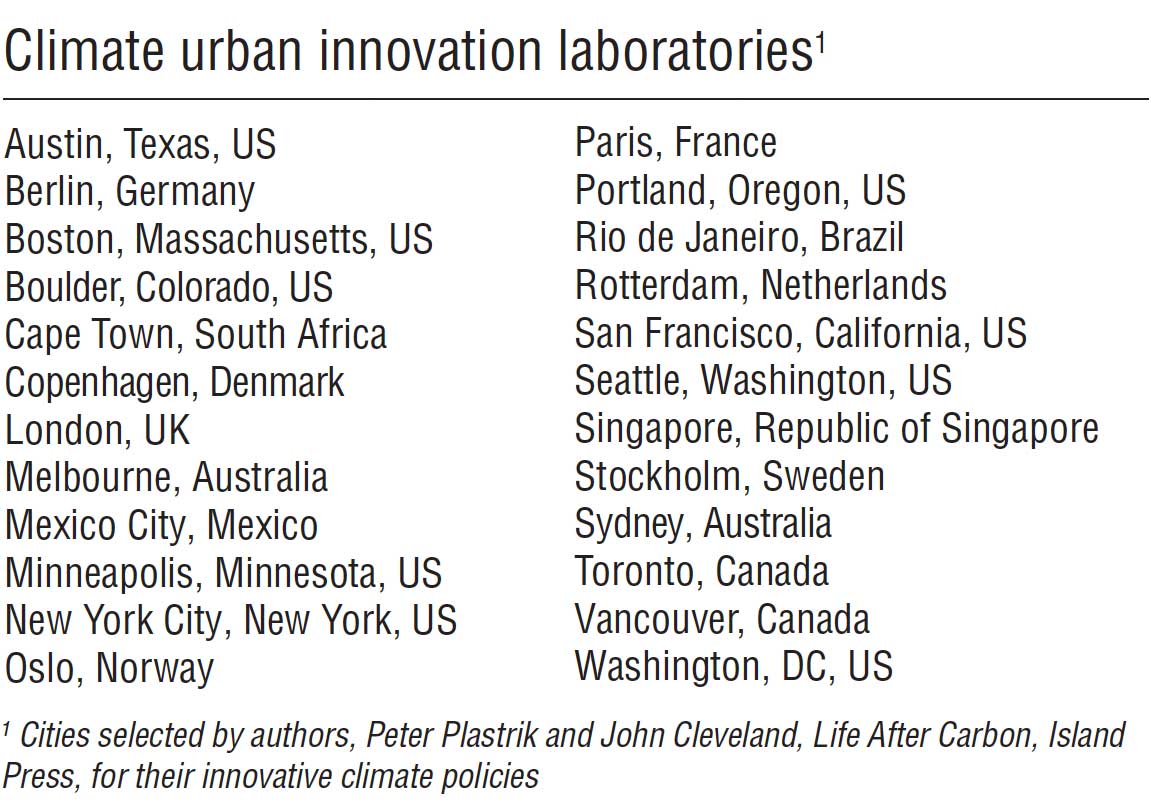
Compact living and climate innovation
Density of population and buildings defines cities in general, but for Urban Climate Innovation Labs—cities that are finding especially creative ways to solve the world’s climate problems—it can be a crucial advantage. A city’s density of habitation, especially its quantity of high-occupancy buildings, generally makes the city more efficient in using energy. When journalist David Owen writes that “New York”—with its miles of concrete, air pollution, and traffic congestion—“is the greenest community in the United States,” the idea may seem preposterous. But not when density and public transit are part of the equation. As Owen explains, “New Yorkers, individually, drive, pollute, consume, and throw away much less than do the average residents of the surrounding suburbs, exurbs, small towns, and farms, because the tightly circumscribed space in which they live creates efficiencies and reduces the possibilities for reckless consumption.”
Urban compactness offers an efficiency advantage that builds on density, one that many cities had before they were designed for the automobile and that “innovation lab” cities are busy reclaiming. Compactness refers to the proximity of stores, jobs, and amenities to where people live—a development pattern that shortens routine travel distances and changes how people travel. “Mixed use is a rarity in sprawled cities where homes, workplaces, schools, hospitals, and shops are segregated from each other,” notes Michael Renner, senior researcher at the Worldwatch Institute. The more compactly these necessities are located, the less often and less distance people must drive to get what they need to go.Instead, they may choose more often to walk or bike to nearby destinations, which reduces energy consumption for mobility.

Compactness can also decrease traffic congestion, which wastes human time and reduces economic productivity. Research shows that congestion-related problems cost US drivers nearly $300 billion in 2016 in lost time and economic productivity. In Seattle, for example, the average commuter wasted an estimated sixty-three hours a year stuck in traffic in 2014. Urban compactness can also reduce the cost of living, since a car-free lifestyle (no purchase, insurance, or garaging) becomes more feasible and attractive. And it may enable the repurposing of public space dedicated to cars—roads, streets, and parking spaces.
“Mixed-use, walkable, economically integrated, and transit-rich places define good urbanism in any city,” says Peter Calthorpe, a founding member of the Congress for the New Urbanism and a global advocate for transit-oriented development (TOD). China’s newer cities, says Calthorpe, have high density, but they also sprawl: “Single-use residential blocks of largely identical units are clustered in superblocks surrounded by major arterial roads. Vast distances separate everyday destinations and create environments hostile to pedestrians. Sidewalks rarely are lined with useful services, and crossing the street is death-defying. Job centers are distant and commutes are long, especially for low-income people.” This urban design reflects a desire “to move cars efficiently; people are an afterthought,” Calthorpe concludes.
In 2015, however, China’s national government adopted a version of TOD standards for cities’ growth. “All future urban development must feature dense road networks, small blocks, and other sustainable urban design principles,” notes Energy Foundation China. “The new guidelines prioritize walking, biking, and public transit. . . . This is a radical departure from the country’s last 30 years of urban development.” A year later, a street-design guide for Shanghai focused on reclaiming streets from automobiles by “paying attention to how people meet and live” and “promoting the joint development of neighborhoods and streets.” In Portland, a growing city with 640,000 residents, a push for compactness began four decades ago—before climate-change awareness—when a coalition of farmers and environmentalists got the state to adopt an urban-growth boundary around Portland and other cities in the region to prevent sprawl. “It was assumed that how we grow and accomplish this regional objective was inextricably tied to our transportation planning,” says Joe Zehnder, Portland’s chief planner. “It’s the bedrock of our compact planning.” To reduce dependence on automobiles, the city embraced mass transit: “There’s a very strong transit culture in the city, and support for continuing to build out that system.” But having mass transit isn’t enough, Zehnder says. “We need to design transit to support compact development, so the benefit of being a household in one of the city’s centers is that you’re less dependent on the car.”
As Portland expanded its transit system, it also promoted the idea of the “20-minute neighborhood,” places where residents can meet their daily non-work needs by walking or cycling. Portland’s Climate Action Plan calls for neighborhoods in which 90 percent of residents can walk or bicycle to meet these needs. The city’s long-range, comprehensive plan envisions “complete neighborhoods” with “multi-story buildings, well scaled streets and businesses and shops and restaurants that meet the everyday needs of residents.”
How “innovation lab” cities are becoming more compact
- A scenario for future growth in Mexico City, a sprawling, heavily congested city, assumed that most new development to accommodate 2.7 million more housing units by 2050 would be mixed-use, walkable, and located around bus and train-line stations—a transit-oriented development (TOD) approach that builds up a set of compact centers with residential and commercial density around access to mass transit, which connects the centers to each other. Compared to a business-as-usual scenario for development, the TOD scenario projected dramatic changes for the city: Reduced use of land, infrastructure costs, water consumption, carbon emissions, household costs, congestion, and air pollution, along with reduced auto miles traveled and average travel time per day. Source: Peter Calthorpe, "Urbanism and Global Sprawl," in Worldwatch Institute, Can a City Be Sustainable (Island Press, 2016).
- Cape Town’s five-year transportation plan, adopted in 2017, embraces TOD—“prioritizing the right development in the right locations, along major road and rail corridors in Cape Town,” an approach that “will reduce travel times and costs, as well as deliver important environmental benefits.” So important is TOD to generating “spatial transformation” and sustainability of Cape Town, that the city expanded its Transport Authority to include all urban development. Source of Cape Town quote: City of Cape Town, "Integrated Transport Plan," July 2017.
- Four other innovation labs—Melbourne, Paris, Portland, and Vancouver—featured in a “green-growth” study by the Organization for Economic Co-operation and Development, which detailed a cluster of innovations involved in urban compactness: targeting infill development for greenfield and brownfield areas, setting minimum density requirements for new development, promoting mixed-use for land and TOD in built-up areas, and encouraging the greening of built-up areas. Source: OECD study, "Compact City Policies: A Comparative Assessment," 2012.
This article was excerpted from Life After Carbon: The Next Global Transformation of Cities by Peter Plastrik and John Cleveland. Copyright © 2018. Reproduced by permission of Island Press, Washington, DC.





